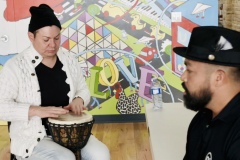What does Filipino Martial Arts, Hip Hop, and Occupational Therapy have in common? They are not only all part of my ‘therapeutic tool-belt’ as a certified trauma practitioner-clinical, but they are also my passions and talents that I have used my whole life as an actor, performer, speaker, and entertainer. As a martial artist, taekwondo master, filipino arnis/eskrima/kali practitioner (under Guro Oliver Salvador), bboy, pop’n locker, and beatboxer, I have been performing and expressing myself as an artist for over 3 decades. Whether it was competing in national competitions, acting in commercials, or performing at music festivals, from an early age, my parents have always instilled in me a passion for developing my talents and using performance as a creative outlet to build my character.
I grew up performing filipino cultural dances such as the “Tinikling” (the national dance of the Philippines involving long bamboo sticks that are rhythmically clapped together and dancers gracefully and athletically jumping through them, which imitates the crane-like birds that would move through the rice paddies of rural Philippines) among other Filipino dances. Rhythm and beat coordination is not only in my blood, but I believe it has become second nature to me as a performer. Another percussive dance called “Sakuting” (It was originally an all-male dance performance presenting a mock fight between Ilocano Christians and non-Christians using sticks), I believe is a representation of the many warrior tribes that has used the art of kali/eskrima/arnis to defend your family’s belief systems. For me, this dance also helped me become more coordinated as a martial artists in training with knives, bolos, and sticks in my Filipino martial arts journey. Little did I know that I would be able to continue sharing and learning these art forms but also respect them in a way that I could never have imagined: to combine them with my trauma-informed occupational therapy practice (and do it in an award-winning TV show to boot!).
Where does the trauma-informed care aspect come in? Well, I’m glad you asked because simply put, one of the best ways to begin working on self-regulation and trauma is through Mind Body Skills. I have learned from the STARR Institute and the National Institute for Trauma and Loss In Children and Adolescents that Mind Body Skills can involve breath work, mindfulness, body positioning, repetitive movement through the use of self-expressive arts to help someone build more resilience and healing of the para-sympathetic response from a single traumatic event or from chronic stress from being exposed to a challenging environment. The beauty of this approach is that a person does not need to necessarily undergo psychotherapy or cognitive behaviour therapy in isolation to support a person who is living with trauma but rather focus on the present feelings and body sensations and this can help the person’s vagus nerve slowly return to homeostasis (in other words, allow the person’s brain to regain a sense of present safety, belonging, and nurturing connection to other people). This is not to say that Mind Body Skills to replace psychotherapy by any means, however, it is an example of how people can also use every day strategies through physical activities, mindful art self-expression, meditation, and yoga to help them cope with their daily challenges living with anxiety, depression, and PTSD.
Check out Season 2 of Queen of The Oil Patch (and the webisode above) to see how I used my passions in Filipino Martial Arts and Hip Hop as a not only a fun activity for Massey Whiteknife, but also a very much intentional therapeutic approach for treating the effects of trauma. Seasons 1 & 2 of Queen Of the Oil Patch can be viewed on APTN and available for streaming now on the APTN Lumi App.














